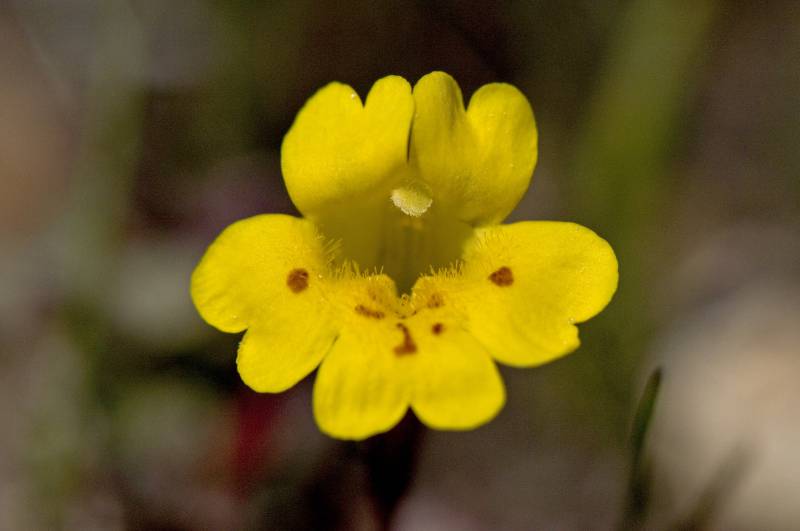Erythranthe primuloides
Erythranthe ampliata
primrose monkey-flower
Nez Perce monkey-flower
Leaves opposite, crowded near the ground, short-hairy abaxially (underside), viscid to glabrous adaxially (upperside);
leaves oblanceolate, sessile, nearly entire, 3-nerved from the base, 7-25 mm. long and 3-11 mm. wide.
Leaves cauline, basal leaves not persistent; petiolate, 8-20 mm;
blade broad-ovate to lanceolate, 8-25 mm long and 5-19 mm broad, venation palmate, wedge-shaped base, margins toothed or somewhat finely toothed, apex acute to obtuse, surfaces glandular and hairy as stems.
Flowers solitary on slender pedicels up to 10 cm. long arising from the leaf clusters;
calyx narrow, 4-8 mm. long, mostly glabrous, the 5 teeth short, equal;
corolla yellow, often dotted with maroon, 1-2 cm. long, scarcely bilabiate, the 5 lobes spreading, shallowly notched, the throat somewhat flaring;
stamens 4.
Axillary flowers 1-10, emerging from nodes throughout; fruiting pedicels glandular-hairy as stems, 10-22 mm;
calyx tubular-campanulate, sometimes weakly inflated, 6-8 mm, margins with distinct serration or lobes, sparsely covered with minute stalked glands or not;
corolla yellow with occasional small white patches, lower limb with several brownish spots, bilaterally symmetric and distinctly bilabiate;
tube-throat broadly funnel-shaped, generally 8-12 mm, protruding beyond calyx margin;
lobes obovate-oblong with rounded or truncate apexes;
styles glabrous;
anthers not protruding, glabrous.
Capsule.
Capsules 5-6 mm, included.
Erythranthe primuloides
Erythranthe ampliata
- Local floras:
CA,
OR,
WA
- Local Web sites:
CalFlora,
CalPhotos,
Flora NW,
PNW Herbaria
WildflowerSearch
iNaturalist (observations)
- LBJ Wildflower Center
- SEINet
- Plants of the World Online
- Encyclopedia of Life
- Wikipedia
- Google Image Search
- Local floras:
WA
- Local Web sites:
Flora NW,
PNW Herbaria
WildflowerSearch
iNaturalist (observations)
- LBJ Wildflower Center
- SEINet
- Plants of the World Online
- Encyclopedia of Life
- Wikipedia
- Google Image Search


